VOL. XVII, No. 4 | WASHINGTON | APRIL, 1906 |

Our Plant Immigrants *
An Account of Some of the Results of the Work of the
Office of Seed and Plant Introduction of the
Department of Agriculture and of Some
of the Problems in Process
of Solution
* The substance of an address to the National Geographic Society, February 9, 1906, and published by permission of the Secretary of Agriculture.
By David Fairchild
Agricultural Explorer, in Charge of Foreign Explorations
(Click here for Dr. Fairchild’s original article in tiff (2 MB) or pdf (1.8 MB) format.
 |
| A basketful of Japanese Loquats as sold in the market of Malta. One of the new fruits of promise. |
The era of pork and hominy has passed forever in this country, but so short a time ago that our fathers refer to it as the time of plain living. What has wrought this change throughout the table menus of the country since the days of the California gold fever? It is not the gold fields of the Pacific slope, nor the industrial development of the country that has caused it, so much as the introduction of new food plants. The changes that have been going on since those wagon caravans followed each other across the great plains have been gigantic, but in no respect have they been more remarkable than in those which Plant Introduction has brought about.
Slowly at first, with the establishment of those plants that the immigrants brought over with them, this work has gone on, unchronicled by historians, until today the very things that we look upon as characteristic of great regions of the country are vast fields and enormous orchards of introduced plants.
Some Noted Importations
The discovery of gold at Sutter’s mill was the beginning of the great industrial development of the Pacific coast, but the introduction by the Catholic Fathers of a single forage plant—alfalfa——has turned two million acres of land into the most generally profitable farm area of this country.
 |
| Century old Olive Orchards in the island of Zante, Greece |
These same Fathers brought with them to their missions olive cuttings, whose descendants today cover thousands of acres of the best tilled olive orchards in the world. A few orange cuttings from the east coast of Brazil, called to the attention of the world by an American woman, have grown until they number their descendants by millions and form what is one of the characteristic features of California — its orange groves.
The tomato, which before the war was a curiosity from Peru and was used to frighten slaves into obedience, because they thought it poisonous, was grown last year on over half a million acres of garden land.
The lima bean, whose arrival in this country no historian has considered worthy of chronicling, has so grown in importance since its introduction, some time about 1820, that today special freight rates are granted it between southern California and the Atlantic coast, and thousands of acres of land where the rainfall is extremely light are devoted almost exclusively to the cultivation of this Peruvian bean.
The potato, from the highlands of Colombia and Peru; the rhubarb, from central Asia; the asparagus, from England, and even the celery of southern Europe, have all been, one after the other, introduced into our fields and gardens.
Though these great changes in the farm and garden areas of the country have been wrought in less than a lifetime, they have still been too slow, and today changes as far-reaching and important as the introduction of the olive or the orange are being brought about by government aid in a surprisingly short time.
The Department of Agriculture is growing in this country some of the things that we now import and for which we pay annually many millions of dollars; it is forcing into public notice and encouraging the trial of foods that the people of other countries find excellent and of which we are ignorant; and it is bringing in from all parts of the world plants that are now wild, but that can be tamed by breeding with others now in cultivation, thus contributing to the creation of fruits and vegetables that the world has never seen before.
This is the government enterprise of Plant Introduction—to introduce and establish in America as many of the valuable crops of the world as can be grown here; to educate the farmer in their culture and the public in their use; to increase by this, one of the most powerful means, the agricultural wealth of the country.
Our Farms and Farmers the Best in the World
No nation in the world has an agricultural territory with a greater range of climatic conditions than the United States and its possessions. Great Britain, “on whose flag the sun never sets,” has her colonies scattered through all the possible ranges of climate, but America has in one great connected area a territory that is exposed in its north to a temperature of fifty degrees below zero in winter and whose southern tip juts out into the zone of perpetual warmth.
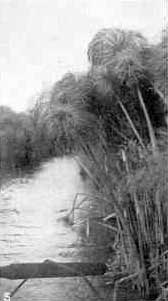 |
| The Egyptian Papyrus. Most beautiful of water plants for Florida streams |
This great farm land is peopled from one end to the other with pioneers; not with peasants whose fathers and grandfathers were peasants and who follow blindly in the footsteps of their forefathers, but with men who have the spirit of change in them and who are looking for anything that will pay better than what they already have. These pioneers, through the daily press and by means of the rural free delivery, are keeping in touch with the plant industries all over the world. They know what the wheat crop of the Argentine is likely to be, and whether Russia’s output of this grain will affect the price of the wheat in their stacks. They see accounts of plant cultures in other lands that they would like to try in their own fields or gardens, and they have the time and the money and the land necessary; but they cannot get the seeds or plants to experiment with, nor do the papers tell enough to enable them to judge whether there is any chance of successfully growing these strange crops on their land.
 |
| A Sample Cutting and the way it is put up and mailed to the Department of Agriculture
Photo from U. S. Department of Agriculture |
“New Things to Grow”
Millions of dollars are waiting to be invested in these new crops, and hundreds of thousands of private experimenters are ready to try new things. A flood of emigration has set in from our great cities to the country, and the emigrants are not poor people, nor ignorant, hut are in large part the wealthy and intelligent, few of whom are willing to follow in the old ways of farming and gardening. They want something new to grow, not always because they think it will be more profitable, but because they will get more amusement out of it, To manage a farm and make it pay along the old lines is indeed a great accomplishment, but to take up something entirely new and prove that it will grow and be profitable gives the same kind of pleasure that always comes to one who makes two blades of grass grow where one grew before. It is the keen pleasure of discovery, the old pioneer spirit, that is turning from the creating of new business projects into new fields of agriculture. These are the new conditions in American agriculture that must ‘be met by new means, and the Department of Agriculture, through the Office of Seed and Plant Introduction, is striving to meet these demands. This office, with its small appropriation of $40,000 a year for the introduction of foreign plants, is getting seeds and plants from the most remote corners of the world for thousands of private experimenters and for the state experiment stations of the country. Over a dozen new things a day are entered on the list of new arrivals, and these new seeds or plants arrive by mail, express, and freight, in quantities varying from a single cutting in a tin tube to a ton of seed of some African or Arabian grain.
These things are not sent broadcast over the country; they cannot be had merely for the asking. Each new shipment represents a well-thought-out problem, for which some preparation has been made, and the seed is too valuable to be wasted by putting it in the hands of those who want it merely because it costs nothing, or who live in a region which the meteorological data in the office excludes from consideration as a place where the new plant is likely to find a congenial home. The new arrival goes out to some experiment station or to some one who has satisfied the office that he has the necessary means to take care of it and the soil and climate in which it will be likely to grow —to experimenters, in other words, who have demonstrated their ability to try new plants. These are chosen from the organized institutes of research in each state and by correspondence with private individuals.
 |
| Monument in Churchyard of Fukushoji, Province of Ku, Japan, erected as a memorial to the man who first introduced citrus fruits into Japan 1,800 years ago. His name was Tajima Mori, and he was sent to China by Imperial order to obtain the citrus fruits. It took him nine years to secure the plants for introduction. The monument bears the following inscription: “How Magnificent is the Result of Tajis’ Work” |
Agricultural Explorers
The securing of these things from the ends of the earth is a work that has required the employment of exceptional men, whose enthusiasm for discovery would take them into dangerous places and whose training had fitted them to tell at a glance whether there was in a new plant the possibility of its utilization in this country. These men have been botanists in the main, but not collectors of dried plants. They have been investigators of new crop possibilities, and have kept always in view the fact that what the country wants is something that will grow and be profitable. The finding of a new species did not distract them from the object of their search, which was to find the plant, whether new to science or not, that was wanted for the improvement of an existing industry or the establishment of a new one.
The ground covered by these agricultural explorers has been great, and in this work of exploration the office has been most fortunate in enlisting the personal support of America’s greatest traveler, Mr Barbour Lathrop, of Chicago. Mr Lathrop, at his own expense, conducted his explorations for nearly six years into most of the promising plant-growing regions of the world, taking the writer with him in all his travels as his expert. With the host of correspondents established during these long voyages and those made by the various agricultural explorers that the office itself has kept in the field, the machinery of getting new plants is better organized in this office than anywhere else in the world. We have traversed the Russian steppes and entered Turkestan; we have scoured the coast of North Africa from the Suez Canal to Morocco, visiting oases in which no white man has been for twenty-five years; we have investigated the industries of Italy, Greece, and Austro-Hungary; the Valley of the Nile, with its host of irrigated crops, has been given a thorough study; Japan, with its peculiar and suggestive agriculture, has been drawn upon by our explorers; India and the Dutch East Indies, with their wealth of material of value for the warmer portions of the country, have been touched, but not yet explored; Arabian date regions have been visited and their possibilities exploited; South America has been given a short visit of reconnaissance; and East Africa, Cape Colony, and the Transvaal, Sweden, and Finland have been visited but not explored. The almost unlimited plant resources of the Chinese Kingdom are being probed by a trained agricultural explorer, Mr Frank N. Myer. Hosts of things are coming in from his explorations that we are not yet in a position to talk about, since few of them have left the cool chambers in which they will remain until planting time, in the spring. Hardier persimmons and peaches from the original home of the peach, interesting new grapes, luscious Chinese pears, and hardy bamboos are on the long list of things already en route to America.
A glance at the great plant industries of this country shows that they have nearly all of them been influenced in the past and are still being changed and bettered by the introduction of new plants.
The Durum Wheat Industry
 |
| A Durum Wheat Field at the New Mexico Experiment Station.
20,000,000 bushels of this wheat were harvested in the United States in 1905 [From M. A. Carleton, U. S. Department of Agriculture] |
The durum wheat, from which the bread of the common people is made in Southern Europe and Russia, was almost an unknown thing on our grain markets until I9oo; but today it is a living question in the milling centers of the Northwest. It is a wheat for the dry lands, where the ordinary kinds grow poorly or not at all, and it yields so much more per acre and is so much surer a crop that, even if it should not bring the highest prices, it will pay better than the less drought-resistant species which Western farmers have hitherto tried to grow on the dry farm lands of the Dakotas and Nebraska.
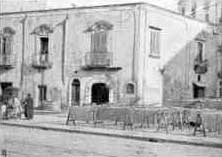 |
| Macaroni made in Naples. Exposed to the dust and dirt of the street |
Custom still fights the innovation of a new flour, and there are people who think our bread is in danger of being deteriorated by the new introduction; but they are not the well informed who have tasted the full-flavored durum wheat breads of Spain or Italy or who realize the great and growing future of macaroni as a food in this country. American-made macaroni, prepared with the best of the old American wheats, cannot be compared with the delicate product of a Gragnano factory. But with the culture of this durum wheat in America a change is coming, and the time may come when we shall ship macaroni to Italy instead of importing it at the rate of nearly $2,000,000 worth a year. This innovation in the great wheat industry has been the result of the efforts of Mr M. A. Carleton, who was sent to Russia as an agricultural explorer of the Office of Plant Introduction in 1898 and I9oo. The office has distributed thousands of bushels of the durum wheat varieties gathered by him from all the Mediterranean arid South Russian countries where it is grown.
The Smyrna Fig
 |
| Packing Figs in a Smyrna Fig Establishment [From Gustav Eiseii, U. S. Department of Agriculture] |
 |
| Distributing Insect-laden Figs in a Smyrna Fig Orchard in order to fertilize the flowers.
Photo from George C. Roeding, of Fresno, California |
One of the most fascinating events in the history of plant introduction was the introduction of the Smyrna fig industry. The Smyrna fig has always been considered the finest fig in the world, and beyond all competition; so it was natural that progressive Californians should wish to see if they could not grow it. Orchards were accordingly started in i88o. They grew well, but the crops of fruit they bore fell to the ground when quite green, and it was evident that something was lacking to make the industry a success. A study of fig culture in Smyrna was made, and it was discovered that a process called caprification was necessary. This consisted in hanging in the trees of the true Smyrna fig the young fruits of another variety of figs that are not edible, but which contain thousands of microscopic wasp-like insects, calledBlastophaga. These insects creep out of the caprifigs just at the time when the Smyrna figs are in bloom, and, crawling into the latter, they fertilize the hundreds of small flowers of which the fig is composed, and instead of dropping off like unfertilized flowers, the Smyrna figs grow and ripen.
The caprifigs were accordingly imported as cuttings, but again the owner was disappointed when the trees bore, for it was discovered that they had left their tiny insects behind and were worthless. A final attempt was made through the combined efforts of the entomologist of the Department of Agriculture and Mr W. T. Swingle, of the Bureau of Plant Industry, and, in 1890, after nineteen years of effort, Mr Roding’s orchard of Smyrna figs was established. It is still the largest in this country and has been yielding large crops of delicious fruit. Sixty-five tons was the output for 1903, and though in its infancy the California Smyrna fig industry is already supplying a portion of the figs now sold in our markets, and these are being put up with a cleanliness unknown in their native land.
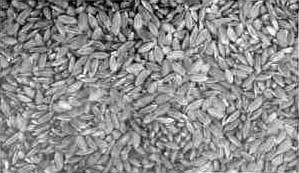 |
| The Short-kernelled Japanese Rice that does not break in milling. |
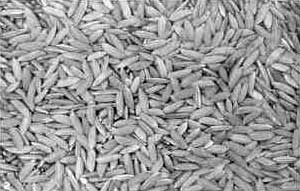 |
| The Long-kernelled Rice which broke badly when milled |
Japanese Rice
History tells us that the first rice in this country was introduced into the Carolinas in 1695 by the captain of a brig from Madagascar, who gave some seed to Governor Smith and his friends to experiment with, and the result has been an important industry. The rices which chance introduction had brought in were looked upon as the finest in quality in the world and were exported to Europe; but with the call for a whiter and a more polished product than the hand-threshed rice of plantation days came machine- polished rice, and the center of the rice industry was transferred to Louisiana and Texas by the discovery of artesian wells in those states. The machine- polished rice that we buy in this country today is, as every one knows, a truly beautiful thing to look at, but as tasteless as the paste that a paperhanger brushes on his rolls of wall paper. The leather rollers of the machine not only rub off all the fine outer layer of nutritious matter, and with it the part that gives flavor to the kernels, but they often break the long, slender grains that characterize the famous Carolina golden rice. This breakage is so great that the Louisiana growers begged for assistance, and the new Office of Plant Introduction sent Dr. S. A. Knapp to Japan in search of a short-kerneled variety that would not break in the milling process. Today Dr. Knapp declares that one-half of all the rice grown in Louisiana and Texas is the Kiushu rice that had its origin in the introduction made in 1899. This new rice has reduced the breakage from 40 per cent to 10 percent, and has at the same time brought into culture a more productive rice.
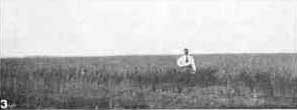 |
| A Japanese Colonist in his Field of Japan Rice in Texas |
It has not done away with the pernicious practice of polishing, but an interest in the unpolished rice has lately been aroused that, it is hoped, will lead to the abandonment of a practice which robs the buyer of nearly all of the flavoring matter of the rice and leaves only the starchy portion. It is a disgrace that the most intelligent nation in the world should be so ignorant of the food value of the crop, on which more people live than on any other, that they should insist upon having their rice made as shiny as polished glass beads, although in so doing they are throwing away the best part of it. No rice-eating people treat their rice as we do, and it is to be hoped that the small markets that have been started for the unpolished rice in this city and elsewhere will lead to a general propaganda in its favor.
The Corsican Citron Industry
The Corsican citron is better known to housewives than to the general public, though a failure to put thin shavings of candied citron rind into the poundcake would be quickly noticed by the household.
Though no one person eats in a year any large amount of citron, yet every one eats a little, and the aggregate amounts to over 2,000,000 pounds a year, almost all of which is imported from Italy and Corsica. To assist a progressive Californian who thought he had the right kind of land and a climate in which to grow the Corsican citron, the writer was sent to the birthplace of Napoleon by the pomologist of the department in 1894. It was the first time I had ever tried to get from a foreign people the plants with which to start an industry that would eventually remove one of its best buyers from the field and might some time lead to the appearance of a rival industry. I was nervous and had been advised that the Corsicans were not inclined to let scions of their fine citron trees go out of the country; so on landing at Eastia, the the port nearest Italy, I pushed through to tile center of the island; and there, in a small mountain town, perched on one of the characteristic pinnacles of land, surrounded by groves of citron, I made my mission known to the mayor.
While waiting for him to bury one of his friends in a neighboring village I strolled about the place and sought by means of my camera to dispel the suspicions of the crowd that gathered uncomfortably about me. While I stood with my head under the black focusing cloth, with a young mother and her child posing against the stucco wall before me, I was startled by the touch, not too gentle, either, of the guarde civile of the village. “Vos papiers, si’l vous plait,” was the curt demand. I replied in Italian that I had left them at Bastia, at which response, and to the evident delight of the crowd, I was marched off to jail. On an errand that was not likely to be pleasing if explained to the guard, with no papers in my pocket, with a captor whose very look was enough to terrify any one, and in a jail that would rival in filthiness any that the Inquisition ever had, I think there are few men who would not have paled. Seated in the jail, with the guard and his wicked-looking wife glaring at me, I was asked to give an account of the reason of my visit. This I refused to do, but endeavored to find out why an American was arrested for taking pictures of the beauties of this lovely village. To my surprise I found that I was taken for an Italian spy, and the examination of all my belongings only served to increase the suspicion, for it revealed Italian notes on abstruse botanical subjects. For hours I fought in poor Italian for a release, hut not until I found, in a pocket that had been overlooked, a Treasury check for some small amount, and insisted that this was my paper of citizenship, did the guard reluctantly leting go, and I left the town as quickly as I could, cutting from some citron trees as I went, however, enough scions or bud sticks to graft a small orchard.
It was my pleasure, ten years after this, to visit in southern California the orchard that was the result of the introduction of these scions. The industry is on a paying basis today, and Dr Westlake, of Duarte, has his own factory in which he candies a grade of citron that he claims is more digestible than any now sold on our markets.
Udo, A New Japanese Salad Plant
While there is nothing that has been found yet that will compare with lettuce as a salad plant, the Japanese have a vegetable that will give a welcome variety. In Japan it is as common as celery is with us, and is so popular that it is canned and sent to this country for the use of the thousands of Japanese who live here. It is used cooked with Soy sauce and in many other ways, but it might never have been introduced into America but for the fact that a young American girl, Miss Fanny El- dredge, adopted the thick, blanched shoots, two feet long or more, as a salad. By shaving them into long, thin shavings, and serving with a French dressing, she produced a salad with a distinct flavor of its own, a crispness that was unusual, and a pretty silvery appearance. It was found to be a most vigorous grower, resembling a soft wooded shrub more than anything. The methods of its culture were worked out, and seeds were obtained and distributed to hundreds of private experimenters scattered from Nova Scotia to California and from Maine to Florida, and the result has been that shoots suitable for the table have been produced in a dozen places, chiefly on the Atlantic coast. It has grown almost if not quite as well in Washington as in Japan, and has shown itself a heavy yielder. Seedlings have in one year produced astonishing masses of roots, from which quantities of the blanched shoots have been grown in a dark chamber or under a mound of earth.
 |
| Trees of the East Indian Mango. The noted Bombay variety. |
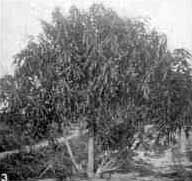 |
| A young imported Mulgoba Mango Tree in Florida. |
The Tropical Mango
Many people think they know what mangos taste like because they have eaten some fruit by that name sold in one of the fruit stores of our cities. The fruits that are offered now as mangos are unworthy the name, for they are from worthless seedling trees and are little more than juicy balls of fibers saturated in turpentine, while the oriental mango is a fruit fit to set before a king. It is in fact more richly flavored than a peach and has no more fiber. The trees grow on poor soil and attain an extreme old age. They bear enormous crops of fruit, that make the trees look when in full bearing as though they were covered with a mass of gold.
The first introduction of the East Indian Mulgoba mango was made into Florida by the Office of Pomology in 1889. From the one tree of this early introduction which survived the freeze of 1895 has come the new mango craze that is now at its height among the Florida planters who have suitable soil and no frosts or only slight ones. When this tree, saved from destruction by Prof. Elbridge Gale, of Mangonia. came into fruit it was a revelation to America, to the Western Tropics in fact. From this one tree thousands of grafted trees are now growing in Florida, and it will not be long before the mulgoba is for sale on our markets. To meet the demand for the best mangoes in the world, the office has brought young plants of the best varieties from every region where they are grown, and there is now assembled in the green-houses of the department the largest and best selected collection of mangoes in the world. These are being fruited in Florida, and the best will be propagated as rapidly as possible for distribution.
Spanish Hard-Shelled Almonds
The Sierras of southeastern Spain produce most of the long, slender kernelled almonds which have come so rapidly into favor for salted almonds. California could produce them, as she already grows the poorer kinds,the soft-shelled, coarser-flavored sorts. To get these finer kinds, the famous Jordan especially, the writer explored the almond orchards of Malaga and Andalusia, and cut scions or grafting wood from the best trees. Much of this material has been used in California with success, but theJordan flowers too early, and another expedition must be made in search of later flowering kinds from the same region to make the hard-shelled type a success, or else new regions must be found in this country where the Jordan will not be caught by the late spring frosts.
 |
| Original appearance of Salt Lands |
 |
| Appearance of the same Salt Lands two years after planting of Berseem |
Berseem, The Egyptian Clover
The greatest annual irrigated forage crop for culture in regions with mild winters is the Berseem of the Nile Valley. It is the crop that the Egyptian fellah, or peasant, has depended upon for centuries as a soil-improver and as a plant on which to pasture his cattle and other animals of the farm. Planted in the late autumn, it grows so rapidly that before the next June it will yield four cuttings of a most nutritious fodder that may be pastured upon, fed green, or made into hay. No other plant known should be so well suited to grow in those newly opened up, irrigated regions of Arizona and California whenever the settlers learn to grow high-priced annual crops instead of alfalfa, which is the main plant industry in that region now.
 |
| Camel loads of Berseem entering Cairo in the early morning. |
Berseem will not come into competition with alfalfa, for it is an annual, while alfalfa is a perennial, and therefore not suited to grow in rotation with crops like cotton, melons, or other annuals. The trials so far made with berseem are encouraging, and the plant has seeded at various places in California and acre plots of it have been grown.
 |
| The beginning of the Government’s Date Garden in California |
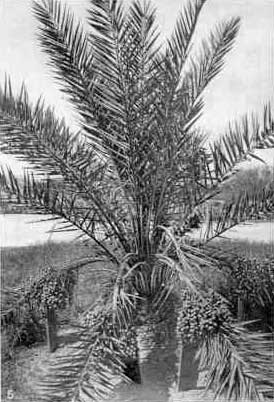 |
| A young California Date Palm loaded with fruit |
The Date-Palm Industry
The transfer from the great deserts of the old world to those of the new of the unique date industry is an accomplishment of which the government may well be proud. It is something that private enterprise would not have undertaken for decades to come, and the name of Mr. Walter T. Swingle will be always associated with this new industry. Though the attention of the public was first attracted to the possibilities of growing the foreign date palm in this country through chance seedlings that bore fruit, and through an early introduction of the pomologist of the department, it was the exploration trip of Mr Swingle to the Desert of Sahara in 1899 that first proved the feasibility of starting commercial date plantations in Arizona and California. From the time when the first large shipment of palm suckers reached the Southwest until the present, the Office of Plant Introduction has had an explorer in some one or other of the great date regions of the old world gathering plants for the government plantations. Today the list of introduced varieties numbers over 170, and more than 3,000 palms, large and small, have been imported and planted out. The best sorts from Egyptian oases, selected kinds from the valley of the Tigris, the famous dates of southern Tunis, and even the varieties from uncivilized Beluchistan, have been gathered into what can proudly be called the best collection of (late varieties in the world. This search through the deserts of the world has revealed the fact that the dates of our markets are only one or two kinds of the host of sorts known to the true date eaters, the Arabs, and that those we prize as delicacies are by no means looked upon by the desert- dwellers as their best. The search has brought to light as well the hard, dry date, which Americans do not know at all, and which they will learn to appreciate as a food, just as the Arab has. Already Egyptian and Algerian imported palms have borne and ripened fruit, and many persons in close touch and sympathy with the work have sampled the first fruits of the newly introduced industry.
 |
| An Arab climbing a Tall Palm in a Garden at Biskra, Algeria, to pollinate the flowers
From Z. T. Swingle, U. S. Department of Agriculture |
To all of us who have seen the date palm forests of the old world deserts and who have followed the progress of the experiments in this country, the landscape of the deserts of Arizona and California will not long be thought of without the presence of these stately plants that have so much that is biblical and ancient about them.
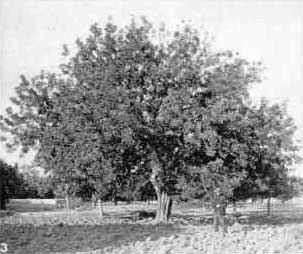 |
| An Orchard of the Carob in full bearing in Spain. |
The Carob Tree or St John’s Bread
No tree of the Mediterranean region is more beautiful than the Italian carrubo, the carob or St John’s bread of the English. In Sicily it is under its shade that the tired tourist stops to rest, and in Spain it is the orchards of the algaroba that attract his attention by their dark- green foliage and picturesque form. Few realize that this tree is seldom planted for its shade or for its landscape effect, but for its pods.
These are born in profusion and are most highly prized as fodder. There are carob-sellers in Spain, just as there are barley-buyers here, and these sellers export their carobs to this country in large quantities. The thick brown pods are full of a sweet honey-like fluid that runs out if you break them open. Cattle and horses are exceedingly fond of them, and children eat them, too, even in this land of cheap candies. Their nutritive value is high, so high in fact that a Wisconsin manufacturer makes one of the best calf foods on the market out of them.
The carob has already found a home in our West, and there are fruiting trees near Los Angeles to prove that it has come to stay.
Egyptian Cotton Introduction
America is the greatest cotton-producing country in the world, but nevertheless over 112,000 bales of cotton were imported from Egypt in 1899. There are distinctly different kinds of this great staple, and the Egyptian cotton supplies a different demand from the so- called upland cotton of this country. It is a variety with a long, very silky and crinkly fiber of a light-brown color, and has been found better than the upland for the manufacture of stockings and underwear and for mixing with silk. It is not the equal of the Seal Island cotton that is grown on the islands off the Atlantic coast, but the area in which the Sea Island varieties can be grown is very limited and the supply is disposed of at fancy prices. It was thought that the Egyptian cotton might be successfully grown in the South, and numerous attempts to introduce it have been made by the department; but while the plants grew well, they proved poor yielders, and their culture has been abandoned, although Dr H.J. Webber has since made a large quantity of hybrids between this Egyptian cotton and the upland sorts and these are more promising.
In the great Colorado River valley, however, which is the American Egypt, and has its dry, mild climate, its irrigation systems, and its long growing season, the Egyptian cotton promises much. There fields of it have been grown that resemble in almost every way the great fields along the Nile, and with the rapid increase in population that is taking place along the Colorado River will come the demand for this, the great money-making crop of Egypt.
Alfalfas From Turkestan And Arabia
From many standpoints alfalfa is the greatest forage crop in the world, and when its immense money value is considered the importance of a better variety, that costs no more to grow than the ordinary one, becomes apparent.
It found its way into this country probably from Asia Minor or Arabia through the roundabout way of Chile. Since its introduction by the Friars in the fifties, its culture has spread, until the area covered by it is over 2,000,000 acres.
With the thought that there was no reason why this Chilean alfalfa should be the best in the world, Mr N. F. Hansen, the first explorer of the office, brought home with him seeds of alfalfa which he found on his exploring trip to the steppes of Siberian and Russian Turkestan.
It is only grown there in small patches, that are cut with sickles in a most primitive fashion. Distributed in large amounts, this seed has proven to be of a variety more resistant to drought and alkali than the ordinary kind, and it is now being grown in acre areas in many parts of the West. While in Arabia three years ago the writer found and imported seed of an alfalfa which the Arab date- growers cultivate, and this has made such an unusual growth in the irrigated regions of the Southwest that the farmers think they can get an extra cutting of hay from it each season.
The Malin Horseradish from Bohemia
Horseradish culture in this country has been generally neglected. Until the introduction by the Office of Plant Introduction of the famous Malin horseradish, only one sort, the common American, was known. In a little village near Vienna the best horseradish in the world is grown. There are two or more other sorts that are recognized in the markets of Europe, but though sold as larger roots, these are not so fine flavored nor so crisp as the Maliner Kren, as it is called. The methods of the Main peasants, too, are superior to those practiced in America, and it was thought at one time that to this difference in method of cultivation rather than to the variety itself was to be attributed its superiority. The introduction of the Malin roots, however, has proven that it is a superior kind, in New Jersey, at Edgewater Park, one of the first men to get the roots grew over six acres this season. Though he had on the same kind of soil, and adjoining the plat where he cultivated the Malin, the American sort, it yielded a ton of roots more than the native kind, was several weeks earlier in coming to maturity, thus commanding a higher figure in the early season, and produced a larger, more regular root. These favorable characters combined have made the Malin horseradish a much better paying one than any other, netting the planter $100 an acre more than the American.
This is a small industry, it is true, but in a single county in that state it has grown from the production of a few hundred pounds a year to that of more than 1,000,000, which means a decided increase in five years in the earning power of a community.
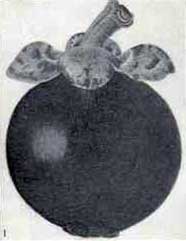 |
| The Mangosteen, queen of the tropical fruits. One-half natural size. |
The Mangosteen From The Malay Archipelago
There is not in the whole range of fruits a single one that surpasses the tropical mangosteen in delicate flavor or in beauty; and yet, because the West Indies do not grow it, Americans who stay at home cannot taste it. Trees, few in number, it is true, are now grown in Jamaica, Trinidad, and even in Hawaii, but the propaganda in its favor has not yet been made and we are now pushing an investigation to establish it as a new industry in Porto Rico, Hawaii, and on the Panama Canal Zone. The mangosteen has a poor root system and it is one of the lines of research we are following to find among the near relatives of the species a form that has better roots and that will serve as a stock upon which to graft the more delicate mangosteen. The genus to which this wonderful fruit belongs has at least fifteen edible species in it, few, if any, being known to those who have not made them a special study. It has a beautiful white fruit pulp, more delicate than that of a plum, and a flavor that is indescribably delicate and delicious, while its purple brown rind will distinguish it from all other fruits and make it bring fancy prices wherever it is offered for sale.
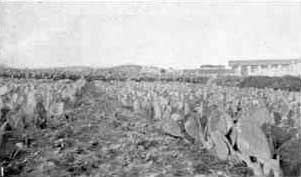 |
| A Field of Spineless Cactus in Tunis. Planted for fodder. |
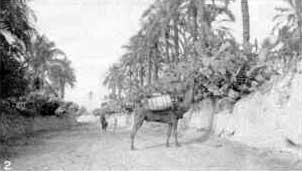 |
| A Camel browsing off the Spineless Cactus of Tripoli |
The Tuna, a Fruit and Fodder Plant for the Deserts
The prickly pear, or tuna, is a fruit that all those who have been in Mexico or Italy or who have visited southern Spain have seen and perhaps tasted. Few, probably, have thought that this fruit was the product of a cactus that would grow in the dry deserts where scarcely anything else will live, and produce fruit on which men can live. It furnishes a fodder for cattle, too, that, though not of the best, is at least good enough to make it worth while to cultivate it in the old world, and in the new it has been utilized by burning off the sharp spines. Native in Mexico, but introduced into the Mediterranean region and into South Africa at a very early date, it has developed astonishingly there, and it is from these parts of the world and from Mexico that we are getting for Mr Griffiths, the opuntia expert of the department all the different varieties. These he is growing in special gardens in California, and it is safe to say that he has already assembled there the largest collections of these plants in the world.
The newspapers have quoted Mr Luther Burbank as claiming to be the originator of the spineless cactus. I do not think that he claims this, but he does think that the so-called spineless forms that the Office of Plant Introduction has brought in are not perfectly spineless, and that he can by breeding and selection remove every vestige of the long spines, and also the almost microscopic spicules that are even more objectionable than the spines, or at least quite as much so.
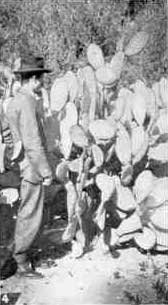 |
| The Spineless Cactus of Tunis |
What some of the possibilities of the opuntia are Mr Spillman, of the Department, has described in a lecture before this Society. The situation is one of the most fascinating in the whole range of plant breeding. Here is a tremendously variable desert plant that can be grown where other plants die; one that can be grown from cuttings as easily as a begonia; one that yields enormous crops of a fruit that is so nutritious that in Tunis, Morocco, and South Africa the natives live on it for months at a time. Though it is so full of seeds that the American fails to appreciate it, it is a fruit of which there are in existence almost entirely seedless varieties from which superior seedless forms can be made; a plant the joints of which are already used for fodder by burning off the spines, making it of value even in the wild state, and of which there are nearly spineless forms now in cultivation in Tunis, Argentina, and southern Spain. Add to this the fact that it is a tremendously rapid grower when given water, and that practically nothing has been done to improve it, and the great possibilities of the plant become apparent.
The Chayote, a Neglected Winter Vegetable
Unless assisted, it takes a long time for even good vegetables to become popular. If one could patent them and control the supply, men would take these new things up and push them, just as they have new breakfast foods, of which they can control the processes. But a new vegetable, what man of moderate means wants to spend all the time and money necessary to advertise it, only to find that his neighbor has waited for a market, and when such has been created has gone into the culture of the new vegetable on a big scale and is underselling him?
The chayote is one of many such neglected opportunities. It is a cucumber-like vegetable, borne on a vine which can be trained over a trellis just like a grapevine. It bears large crops of fruit, as many as 500 to the vine. It is a perennial and does not have to be planted every year, as the cucumber does, but goes on for years producing larger and larger crops. The fruit keeps excellently, and as late as March can be sent to the northern markets. Its roots are edible, its young sterns as tender as asparagus, while its fruits can be prepared in twenty ways or more. The plant adapts itself to culture under glass and bears fruits there, even in the north, though its natural home is in the West Inches, and it will not be a profitable outdoor culture north of the Carolinas.
With all these points in its favor, which were first called to the attention of the American public by Mr O. F. Cook in a bulletin of the Department, and with the further fact that it has been for years a favorite vegetable among the Creoles of New Orleans, there are today none of these vegetables to he had on our northern markets.
To bring its good points to the attention of those who are looking for new things, the writer introduced it to Managers Hilliard and Macormick, of the Waldorf-Astoria, and the Bellevue—Stratford hotels. These men, whose business it is to cater to the jaded appetites of the rich, have pronounced it an excellent thing, have invented new recipes for cooking it, and have put it for the first time on their menues.
If a small demand is once created in our great cities for this new vegetable, that tastes like a combination of a delicate cucumber and a squash, with more firmness than either, there will be created a new industry for the South that will grow as the tomato industry has grown and support people by its yearly earnings.
Plant Problems Now in Process of Solution
The work of Plant introduction is not theoretical, hut practical in character. Its operations are carried on in those places where it is needed, and the problems are suggested by practical men. Some of the problems which the department is now working on are: the finding of paying crops for the abandoned rice farms of the Carolinas; the securing of some profitable plant culture for the unemployed hilly regions of North Carolina and Georgia; the improvement of the brewing barleys of the country; the fitting in of new crops into the arctic agriculture of Alaska; the starting of new industries in our tropical possessions; the increasing of the fertility of the California orchard soils; the introducing of hardy fruits into the Northwest; the substituting of a valuable for a worthless cane in the cane brakes of the South; and the exploiting of a drought-resistant nut plant for California.
The planters of the Carolinas must have a new crop to grow on the rich rice lands that are no longer profitable for rice culture since the great Louisiana and Texas rice fields have been opened up. The Office of Plant Introduction has suggested the trial of the Japanese matting rush as one likely to he a profitable one on these areas, and is planting thousands of seedlings of the plant, and watching them carefully to see how expensive their cultivation will be. It is also experimenting with a new root crop on the cheap sandy lands of the region as a possible substitute for the Irish potato, which will not grow on that soil.
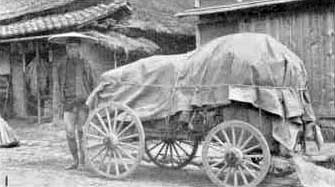 |
| A Wagon Rain Covering, four years old, made of Mitsumata paper, and oiled with Perilla oil. |
 |
| A Hillside in Japan covered with the Mitsumata Paper Plant |
There are also thousands of unemployed acres of hilly lands in the Carolinas where the conditions are good for the culture of the Japanese plant from which the finest writing paper in the world is made, and the Office has introduced and planted there thousands of these plants to see if they will not develop into an industry which will utilize these great waste areas.
The barley-growers of the country are growing millions of bushels of grain for the brewers, but among the hosts of so-called varieties that are recognized on the grain markets not one is a pure race or breed. The Swedes have long since found the use of pure barleys of great advantage to the brewers, and their plant-breeders have created pure types. The Department has imported these, and they are now on extensive trial by the best barley— growers in the country.
Alaska, with its cool, short summers and extremely cold, long winters, offers new problems for Plant Introduction. The crops cultivated by the farmers of the great plains are accustomed to a long, hot summer, and when tried in Alaska they are caught by the early autumn frosts before they are half ripe. To meet these new conditions, Norway, Sweden, and Finland have been drawn upon for grains and vegetables, and the most successful oats grown in Alaska today are the Finnish black oats that were introduced by the Office of Plant Introduction.
For the tropical regions of Porto Rico, Hawaii, the Philippines, and the Panama Canal Zone, there are hosts of new possibilities open. The sisal fiber importations from Mexico cost this country over $i6,000,Voodo a year, and we propose to demonstrate on a practical scale that the sisal plant will grow in Porto Rico and supply a share, at least, of the thousands of miles of binding twine which the Western farmers use in their harvest fields.
There are a host of new fruits which are common in the oriental tropics and which would quickly win their way to popular favor on our markets, waiting to be brought in and made into thriving industries. The run-down coffee varieties need new strains to invigorate them, and it is a possibility that the wild coffees of Abyssinia which Consul Skinner has secured for the Department will bring this about. There are new root crops like the taro, the yautia, and the tropical yam that are almost unexplored, so far as their possibilities as food for the white man are concerned, and whose excellent qualities and remarkable yields put them in the same rank with the potato.
The Curious Properties of the Fenugreek
The great fruit-growers of the Pacific slope, with their thousands of acres of clean-tilled orchards, have been searching for a cover crop that would increase the fertility of their lands and add the necessary humus or vegetable matter to it. We have found this for them in the shape of a leguminous plant that inhabits the Mediterranean region — the fenugreek. The seeds of this plant, curiously enough, are eaten by the Jewish women of Tunis in order to make them fat, and no young Jew in that region would think of marrying a girl until the use of this grain had increased her weight to the fashionable figure of 250 or 300 pounds. The seeds form a part of the expensive condition powders that stockmen use to prepare their stock for tile fat-stock shows, and it was for this purpose that our explorers introduced it in the first place.
For the great Northwest, where fruit trees are killed every winter and none but the hardiest kinds will grow, the explorers have brought in from Russia the hardy Vladimir cherry and forms of the Siberian crab-apple, with the hope of at least starting some types of fruit that will be hardy there.
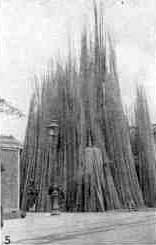 |
| A Bamboo Timber Yard in Japan. |
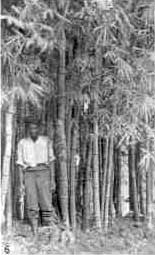 |
| A Clump of the Giant Bamboo in Natal South Africa |
The “cane brakes” of the Southern States are thickets of an American bamboo whose stems are so brittle that they are worthless in the arts. Shipments of the Japanese timber bamboo, from which the thousand and one beautiful Japanese things are made, have been imported and are being tried in those areas to see if they will not grow there and occupy land that today is the ranging ground of wild hogs and half- wild cattle.
A Drought Resistant Nut
Thousands of acres of almond orchards in California have been unprofitable because the rainfall is too light in the regions where the orchards have been started; and to get a more drought resistant nut plant for these areas the pistache from the Levant has been brought in, and there are now being set out at various places in California small pistache orchards, the pioneers of the new pistache industry, that will some day make this delicious nut as common as the almond is, not as a coloring and flavoring material for ice creams, but. as a nut for the table, to serve as salted almonds are now. Mr Swingle, the enthusiastic introducer of this nut, has searched throughout the world for all the pistache species that can be found, some to use as stocks and others to breed from, and there is every prospect that he will succeed in introducing into the arid regions of the Southwest an entirely new nut industry.
These are some of the many problems that the government enterprise of Plant Introduction is engaged in solving.
They are problems that private enterprise will not naturally undertake they are problems that concern the wealth-producing power of American soil; they are problems that the government has shown its ability to solve in a manner involving an insignificant outlay of the public funds. They encourage the production of food and other products that we now import from other lands, and they concern the establishment of farm industries which, for generations to come, will support hundreds of thousands, perhaps millions, of American citizens.